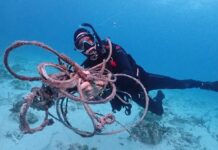BY: WHITNEY WEMETT
Dr. Ross Boucek, Florida Keys initiative manager of Bonefish & Tarpon Trust (BTT), joined a group of local fishermen and community members at the Florida Keys History & Discovery Center recently to discuss the significance of flats fisheries in the Florida Keys and what is being done to ensure their health. A second-generation Floridian, Boucek delved into what flat fisheries mean to the Florida Keys as a culture, what has happened to the fishery in the last 30 years and what it’s going to take to revitalize world-class fishing.
Flats fishing happens in clear, warm waters where anglers can see a fish before they catch it. It is a catch-and-release sport centered around three main fish: bonefish, tarpon, and permit.
Bonefish are known for their long shiny tails that stick high in the sky on the flats. They are a fast and almost transparent saltwater trophy fish that have quite the reputation throughout the Florida Keys fishing community. Considered the ultimate game fish and nicknamed the “silver kings,” tarpon are the largest fish on the flats, reaching upwards of 100 pounds and known for their violent, jumping behavior. Permit are unpredictable, tough fighting fish proven to be the most captivating fish on the flats and often caught using a fly rod. These fish call the seagrass habitats and shallow bottoms that surround the Keys ecosystem home.
What makes flats fishing in the Keys so special? The sport has historical and cultural significance, bringing people from all around the world for days at a time. A no bycatch and catch-and-release sport, it has proven to be a sustainable asset to the community that is worth keeping.
In the last 30 years, Boucek said, these fisheries have been in steep decline, with bonefish first in the mid-1990s and permit becoming less abundant and smaller in recent years. Tarpon are not where they used to be and have changed their behavior to become harder to catch.
What can people do to bring these fisheries back to world-class status? Boucek said flats fisheries, unlike coral reefs, have very fixable problems that can be addressed if the work focuses on different stressors to make sure the fishery is robust and healthy.
With the number of visitors to the Keys increasing each year, so has the influx of boat operators who are unfamiliar with the shallow waters. The number of flats affected by propeller scars doubled in the last 20 years. Boucek said the flats and water quality of the local marine ecosystem are suffering from infrastructure not keeping pace with population growth in Florida. This was evident in the recent 73,000 gallons of wastewater leaked from St. Petersburg city pipes in 2018 when pollutants were brought into Keys waters with favorable ocean currents. A local fisherman who has been fishing the flats for over 40 years in North Key Largo said water quality has affected his success at the sport in recent years.
Much to the surprise of many in the room, Boucek described one of the biggest local natural stressors as having more sharks than ever before. Sonar has shown that sharks are starting to associate boats with food, lurking nearby ready to snatch flats fish as they are lured to the bait or waiting for the fish to be released by the angler.
Through acoustic tagging, BTT follows the highly migratory path of Keys tarpon as far as Virginia to identify national stressors. Once one of the 170 tagged tarpon passes by a receiver, it records the tag number and time, watching day-to-day movement to see where the fish go when they leave the Keys. These silver kings leave the Keys skinny to migrate north to the Carolinas to feed and gain the weight they need to come back to the Keys to spawn.
However, with unregulated commercial bait fishing of menhaden fish in North Carolina and less stringent catch-and-release practices, many Keys tarpon are not returning from their migration north. As bonefish migrate in large aggregations to the Caribbean to reproduce, hurricanes and ocean currents also make it more challenging to maintain single bonefish populations and to keep larvae population healthy.
So what can the Keys do? To have a healthy and prosperous flats fishery, Boucek said, people must treat more fish with respect and spread awareness. This means ensuring the fish caught are released healthy and properly by reducing fight time and handling. For bonefish and permit, keep them in the water and minimize air exposure to increase their chance of survival. Tarpon should be held upright in the water and not dragged by the mouth.
What action is being taken now? Boucek interviews local anglers to identify hot spots where idle zones should be established. BTT is working with the Florida Keys National Marine Sanctuary to put idle speed and poll troll zones on these important flats to protect fish and the arena of the fishery. By working on these different stressors and increasing community education on the fishery, Bonefish & Tarpon Trust is taking steps to invest in a sustainable fishing industry in the sportfishing capital of the world for generations to come.
One of the biggest local natural stressors is having more sharks than ever before. Sonar has shown that sharks are starting to associate boats with food, lurking nearby ready to snatch flats fish as they are lured to the bait or waiting for the fish to be released. Boucek was quick to assure the audience that we can live with the sharks stealing the fish; we like having them around.
























